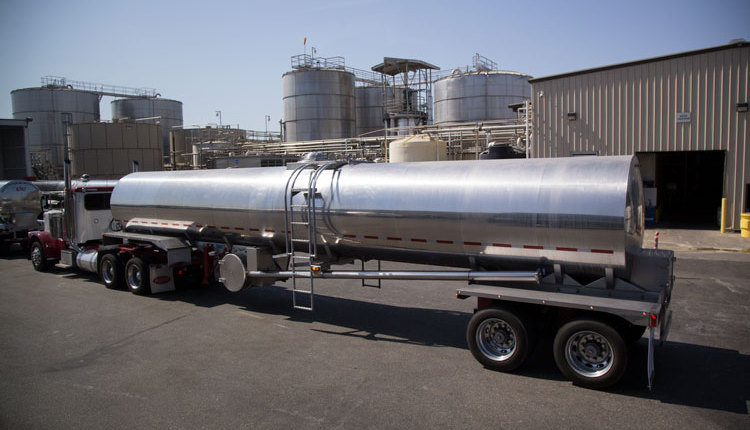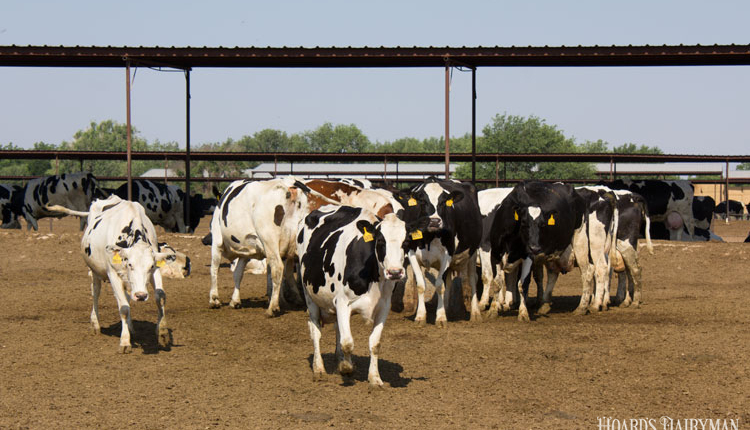The author is a professor and extension dairy specialist with Texas AgriLife Extension Service, Texas A&M University system.
he top reproductive physiologists from around the world met in New Orleans this past summer to share advances in managing reproduction in dairy cows. Some highlights from those presentations follow:
Activity monitors for estrous detection
Description: One of the recent additions to electronic monitoring has been neck-mounted sensors which continuously monitor frequency and speed of movements. Researchers reported on the relationship between the interval of the onset of greater activity and A.I. Based on data from over 4,100 services in 19 herds, the optimum interval from beginning of high activity to insemination was 13 to 16 hours in first-lactation cows. However, for older cows, conception rate was greater for those inseminated less than 12 hours, intermediate for 13 to 16 hours, and least for those bred 17 to 26 hours (see table).

Take-home message: Herds incorporating electronic activity monitoring systems may optimize conception rates by using times obtained from the system to schedule A.I. for best conception rates. Adjustments for specific groups based on lactation should be considered.
Contact: Ray Nebel, Select Sires, Plain City, Ohio; phone: (614) 733-3494; email: rnebel@selectsires.com
Boost summer preg rates
Description: At last year's meeting, Texas and Florida scientists reported that transferring fresh or frozen embryos produced with sexed semen improved summer pregnancy rates in lactating dairy cows compared to A.I. At initial pregnancy diagnosis (40 days), more cows were pregnant with fresh embryos (42.1 percent) versus both frozen embryos (29.3 percent) and A.I. (18.3 percent).
Since that research, the cows have calved. As expected, the percentage of heifer calves was greater with embryos produced with sexed semen. An economic analysis was conducted to estimate the value of using sexed female embryos to improve fertility in the summer compared to using A.I. throughout the year. It was assumed that the cost of embryo transfer with the sexed embryos was $60 compared to $20 for A.I. The service rate was assumed to be 50 percent. The model was designed to simulate effects of heat stress on milk and fat production, fertility, involuntary culling, and death risk. Maximum herd size allowed was 1,300 milking and dry cows or 1,000 lactating cows during each week of the year.
Incorporating embryo transfer into the model enhanced profit per cow per year by $22 when the total size of the herd was constrained. Although total revenue didn't change, replacement costs declined, and breeding as well as feed costs rose.
Take-home message: Incorporating embryo transfer with sexed embryos during summer heat stress raises the number of pregnant cows. The end result is a higher proportion of heifer calves and a positive economic return on the investment for larger herds. You will need to run your own numbers.
Contact: Todd Bilby, Texas A&M AgriLife Research and Extension, Stephenville, Texas; phone: (254) 968-4144; email: trbilby@ag.tamu.edu or Albert De Vries, University of Florida (economic data), Gainesville, Fla.; phone: (352) 392-5594, ext. 227; email: devries@ufl.edu
Pregnancy and embryonic loss detection
Description: Currently, there are three commercial pregnancy tests on the market. These pregnancy tests are based on detection of pregnancy-specific protein B (PSPB) in the blood of cows. The current commercial test guidelines are to wait 28 to 30 days after insemination to check for pregnancy. In addition, cows are to be at least 90 days in milk before the test is conducted.
A NEW test, also based on identifying PSPB, was evaluated by comparing it to the BioPRYN test (BioTracking, LLC). Blood samples were collected from 370 cows in 10 herds in California at 28 ± 2 days since their last heat. At 33 to 42 days since the last heat, a pregnancy diagnosis was made either with ultrasound or rectal palpation, and a second blood sample was taken. If diagnosis conflicted, additional testing occurred 3 to 10 days later.
By 28 days from the last heat, both the BioPryn test and the NEW test identified 100 percent of the cows that were truly pregnant. There were 10 animals that were diagnosed pregnant with the BioPRYN on the first test but nonpregnant on the NEW test; however, these animals were between 70 and 88 days in milk at that test. This is below the current directions of at least 90 days in milk for the BioPRYN test.
In a subsequent evaluation with University of Wisconsin, the NEW and BioPryn tests were compared on a subset of cows at 25 days. The NEW test identified all of the cows as pregnant at 25 days, while the BioPryn test identified five of the pregnancies by 25 days, four at 27 days, and two at 29 days.
Take-home message: The NEW test may allow earlier diagnosis of pregnancy status and may reduce the interval postpartum until blood tests can be used.
Contact: Paul Fricke, University of Wisconsin-Madison, Madison, Wis.; Phone: (608) 263-4596; email: pmfricke@wisc.edu
Synchronization of dairy heifers
Description: Researchers at the University of Idaho and BioTracking evaluated whether GnRH at the time of CIDR insertion in a five-day CIDR timed A.I. (TAI) protocol improved the numbers of pregnancies per A.I. in heifers. All 234 heifers received a CIDR on Day 0. Half of the heifers received 100µg of GnRH at the time of insertion of the CIDR, while the other half served as the control group and did not receive the GnRH treatment. The CIDR was removed from all heifers on Day 5 of the protocol, and each heifer received 25 mg of prostaglandin. Estrous activity was monitored from time of removal of the CIDR (Day 5) until Day 8 when all heifers received GnRH and TAI.
Pregnancies per A.I. did not differ between the two groups at either 32 or 45 days after insemination with 57.2 percent of the heifers receiving GnRH at CIDR insertion pregnant and 61.5 percent of the control heifers pregnant. Across both groups, 82 percent of the heifers were observed in estrus. More heifers detected in estrus (63.3 percent) conceived than those not detected in estrus (41.8 percent).
Take-home message: For heifers only, a GnRH treatment at time of insertion does not improve the number of pregnancies when using a 5-day CIDR synchronization program with a timed artificial insemination 72 hours after CIDR removal and GnRH treatment.
Contact: Amin Ahmadzadeh, University of Idaho, Moscow, Idaho; phone: (208) 885-7409; email: amin@uidaho.edu
Click here to return to the Reproduction E-Sources
110125
he top reproductive physiologists from around the world met in New Orleans this past summer to share advances in managing reproduction in dairy cows. Some highlights from those presentations follow:
Activity monitors for estrous detection
Description: One of the recent additions to electronic monitoring has been neck-mounted sensors which continuously monitor frequency and speed of movements. Researchers reported on the relationship between the interval of the onset of greater activity and A.I. Based on data from over 4,100 services in 19 herds, the optimum interval from beginning of high activity to insemination was 13 to 16 hours in first-lactation cows. However, for older cows, conception rate was greater for those inseminated less than 12 hours, intermediate for 13 to 16 hours, and least for those bred 17 to 26 hours (see table).

Take-home message: Herds incorporating electronic activity monitoring systems may optimize conception rates by using times obtained from the system to schedule A.I. for best conception rates. Adjustments for specific groups based on lactation should be considered.
Contact: Ray Nebel, Select Sires, Plain City, Ohio; phone: (614) 733-3494; email: rnebel@selectsires.com
Boost summer preg rates
Description: At last year's meeting, Texas and Florida scientists reported that transferring fresh or frozen embryos produced with sexed semen improved summer pregnancy rates in lactating dairy cows compared to A.I. At initial pregnancy diagnosis (40 days), more cows were pregnant with fresh embryos (42.1 percent) versus both frozen embryos (29.3 percent) and A.I. (18.3 percent).
Since that research, the cows have calved. As expected, the percentage of heifer calves was greater with embryos produced with sexed semen. An economic analysis was conducted to estimate the value of using sexed female embryos to improve fertility in the summer compared to using A.I. throughout the year. It was assumed that the cost of embryo transfer with the sexed embryos was $60 compared to $20 for A.I. The service rate was assumed to be 50 percent. The model was designed to simulate effects of heat stress on milk and fat production, fertility, involuntary culling, and death risk. Maximum herd size allowed was 1,300 milking and dry cows or 1,000 lactating cows during each week of the year.
Incorporating embryo transfer into the model enhanced profit per cow per year by $22 when the total size of the herd was constrained. Although total revenue didn't change, replacement costs declined, and breeding as well as feed costs rose.
Take-home message: Incorporating embryo transfer with sexed embryos during summer heat stress raises the number of pregnant cows. The end result is a higher proportion of heifer calves and a positive economic return on the investment for larger herds. You will need to run your own numbers.
Contact: Todd Bilby, Texas A&M AgriLife Research and Extension, Stephenville, Texas; phone: (254) 968-4144; email: trbilby@ag.tamu.edu or Albert De Vries, University of Florida (economic data), Gainesville, Fla.; phone: (352) 392-5594, ext. 227; email: devries@ufl.edu
Pregnancy and embryonic loss detection
Description: Currently, there are three commercial pregnancy tests on the market. These pregnancy tests are based on detection of pregnancy-specific protein B (PSPB) in the blood of cows. The current commercial test guidelines are to wait 28 to 30 days after insemination to check for pregnancy. In addition, cows are to be at least 90 days in milk before the test is conducted.
A NEW test, also based on identifying PSPB, was evaluated by comparing it to the BioPRYN test (BioTracking, LLC). Blood samples were collected from 370 cows in 10 herds in California at 28 ± 2 days since their last heat. At 33 to 42 days since the last heat, a pregnancy diagnosis was made either with ultrasound or rectal palpation, and a second blood sample was taken. If diagnosis conflicted, additional testing occurred 3 to 10 days later.
By 28 days from the last heat, both the BioPryn test and the NEW test identified 100 percent of the cows that were truly pregnant. There were 10 animals that were diagnosed pregnant with the BioPRYN on the first test but nonpregnant on the NEW test; however, these animals were between 70 and 88 days in milk at that test. This is below the current directions of at least 90 days in milk for the BioPRYN test.
In a subsequent evaluation with University of Wisconsin, the NEW and BioPryn tests were compared on a subset of cows at 25 days. The NEW test identified all of the cows as pregnant at 25 days, while the BioPryn test identified five of the pregnancies by 25 days, four at 27 days, and two at 29 days.
Take-home message: The NEW test may allow earlier diagnosis of pregnancy status and may reduce the interval postpartum until blood tests can be used.
Contact: Paul Fricke, University of Wisconsin-Madison, Madison, Wis.; Phone: (608) 263-4596; email: pmfricke@wisc.edu
Synchronization of dairy heifers
Description: Researchers at the University of Idaho and BioTracking evaluated whether GnRH at the time of CIDR insertion in a five-day CIDR timed A.I. (TAI) protocol improved the numbers of pregnancies per A.I. in heifers. All 234 heifers received a CIDR on Day 0. Half of the heifers received 100µg of GnRH at the time of insertion of the CIDR, while the other half served as the control group and did not receive the GnRH treatment. The CIDR was removed from all heifers on Day 5 of the protocol, and each heifer received 25 mg of prostaglandin. Estrous activity was monitored from time of removal of the CIDR (Day 5) until Day 8 when all heifers received GnRH and TAI.
Pregnancies per A.I. did not differ between the two groups at either 32 or 45 days after insemination with 57.2 percent of the heifers receiving GnRH at CIDR insertion pregnant and 61.5 percent of the control heifers pregnant. Across both groups, 82 percent of the heifers were observed in estrus. More heifers detected in estrus (63.3 percent) conceived than those not detected in estrus (41.8 percent).
Take-home message: For heifers only, a GnRH treatment at time of insertion does not improve the number of pregnancies when using a 5-day CIDR synchronization program with a timed artificial insemination 72 hours after CIDR removal and GnRH treatment.
Contact: Amin Ahmadzadeh, University of Idaho, Moscow, Idaho; phone: (208) 885-7409; email: amin@uidaho.edu
110125











